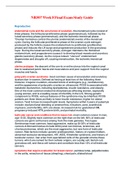Exam (elaborations)
NR507 Week 8 Final Exam Study Guide / NR 507 Week 8 Final Exam (Newest 2022/2023): Advanced Pathophysiology: Chamberlain College of Nursing
NR507 Week 8 Final Exam Study Guide / NR 507 Week 8 Final Exam (Newest 2022/2023): Advanced Pathophysiology: Chamberlain College of Nursing
[Show more]
Preview 3 out of 20 pages
Uploaded on
April 5, 2022
Number of pages
20
Written in
2022/2023
Type
Exam (elaborations)
Contains
Questions & answers
All documents for this subject (41026)
NR507 Week 8 Final Exam Study Guide




